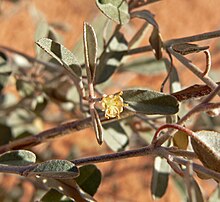Croton (plant)
| Croton | |
|---|---|
 |
|
| Croton californicus | |
| Scientific classification | |
| Kingdom: | Plantae |
| (unranked): | Angiosperms |
| (unranked): | Eudicots |
| (unranked): | Rosids |
| Order: | Malpighiales |
| Family: | Euphorbiaceae |
| Subfamily: | Crotonoideae |
| Tribe: | Crotoneae |
| Genus: |
Croton L. |
| Sections | |
|
see text |
|
| Synonyms | |
|
|
see text
Croton is an extensive flowering plant genus in the spurge family, Euphorbiaceae. The plants of this genus were described and introduced to Europeans by Georg Eberhard Rumphius. The common names for this genus are rushfoil and croton, but the latter also refers to Codiaeum variegatum. The generic name comes from the Greek κρότος (krótos), which means "tick" and refers to the shape of the seeds of certain species.
Croton is a diverse and complex taxonomic group of plants ranging from herbs and shrubs to trees. A well-known member of this genus is Croton tiglium, a shrub native to Southeast Asia. It was first mentioned in European literature by Cristóbal Acosta in 1578 as lignum pavanae. The oil, used in herbal medicine as a violent purgative, is extracted from its seeds. Nowadays, it is considered unsafe and it is no longer listed in the pharmacopeias of many countries.
Croton tiglium oil has been used in traditional Chinese medicine to treat severe constipation, heal lesions, and is used as a purgative. It is a source of the organic compound phorbol and its tumor-promoting esters such as 12-O-tetradecanoylphorbol-13-acetate. In the Amazon the red latex from the species Croton lechleri, known as Sangre de Drago (Dragon's blood), is used as a "liquid bandage", as well as for other medicinal purposes, by native peoples.
...
Wikipedia
